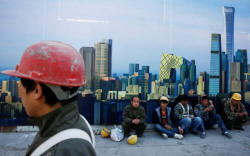|
Report card: tries hard,
could do better
 Send a link to a friend
Send a link to a friend
 [May 12, 2017]
By Jeremy Gaunt [May 12, 2017]
By Jeremy Gaunt
LONDON
(Reuters) - Setting aside a few uncomfortable economic truths such as
the increasing U.S. skills gap, eye-wateringly high unemployment in
parts of the euro zone, and growing income inequality in China, the
world economy has been doing pretty well this year.
The issue is: how well and how sustainable?
In the United States, the economy has been strong enough for the Federal
Reserve to start raising interest rates, slowly. In the euro zone,
growth is robust enough for the European Central Bank to think about
dropping public warnings of risks.
China, meanwhile, has so far staved off last year's dire warnings of a
sharp, potentially damaging, slowdown.
But much of this comes courtesy of billions of dollars, euros, and other
currencies being pumped into the global economy. In some cases, it is
still being pumped in.
And the results are not exactly bracing. The International Monetary Fund
expects the world economy to grow 3.5 percent this year --- not bad
until you remember it averaged 4.2 percent over the 10 years before the
financial crisis.

The IMF sees the U.S. economy growing at 2.3 percent this year, below
the 2.6 percent average for 1999-2008. Ditto the euro zone -- 2017
growth at 1.7 percent versus 2.1 percent. For China, the numbers are 6.6
percent and 10.1 percent, respectively.
After their spring meeting last month, the IMF and World Bank sounded a
bit passionless about it all.
"The global economy is gaining momentum, but risks remain tilted to the
downside," they said.
So a near 10-year deluge of global central bank stimulus has not brought
things back to where they were and a left a large question about the
sustainability of what has been achieved.
As European Central Bank President Mario Draghi said in a slightly
different context in the past week: "It is too early to declare
success."
Most economists appear to believe the global economy is strong enough to
keep going, if not exactly at a tear. The coming week will probably
confirm this, but could also provide something of a reality check.

[to top of second column] |

Workers sit outside a construction site in the Central Business
District in Beijing, China, April 18, 2017. REUTERS/Thomas Peter

TICKING AWAY
In what may be an example for the global economy as a whole, the United States
is expected to report slower industrial output growth for April -- that is, it
continues to grow (at 0.3 percent), but at a lesser rate than March's 0.5
percent.
But more attention is likely to be paid to the respective reports of the Federal
Reserve banks of Philadelphia and New York -- the Philly Fed and Empire State.
Last
time around, they both signaled growth, but with the New York report far less
robust than the Philly. Same again?
China's economy, meanwhile, has shrugged off fears of a major slowdown. It is
expected to slow from surprisingly strong first quarter growth, however, as
previous stimulus measures wear off and policymakers set their eyes on
controlling risks in the financial market.
In the coming week, data may further confirm a slight slowing of momentum, but
nothing dramatic. Year-on-year retail sales, for example, are expected to dip to
10.6 percent from 10.9 percent.
The euro zone will offer up its second reading of first quarter GDP growth, the
first coming in at 0.5 percent quarter on quarter.

Analysts polled by Reuters expect no change, but industrial production data for
March did come in far softer than expected.
Another focus will be on the final April figures for inflation. Again, no change
expected -- 1.9 percent year-on-year -- but the ECB will be watching to make
sure all that money it has pumped in does not take the number too much higher.
(Additional reporting by Elias Glenn in Beijing; Editing by Catherine Evans)
[© 2017 Thomson Reuters. All rights
reserved.] Copyright 2017 Reuters. All rights reserved. This material may not be published,
broadcast, rewritten or redistributed. |